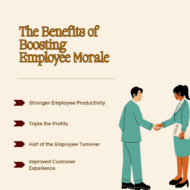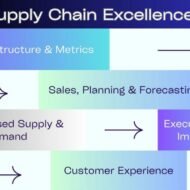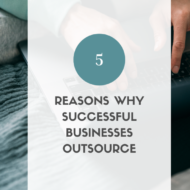Currently Browsing: Productivity
Posted by Managementguru in How To, Human Resource, Productivity
on Jun 22nd, 2023 | 0 comments

As a manager, it is essential that you know how to keep your people happy. When your entire team has high morale, the whole business can benefit. High morale can increase productivity, reduce staff turnover and create a positive workplace atmosphere. This will also allow you to excel in your role as a manager, give you great job satisfaction, and improve your relationships with your team members. So, what can you do to keep your people happy at work? There are a few methods that you can use that should lift morale and improve the performance of your team and business as a whole. Offer Flexibility First, it is important that you offer flexibility. Flexible working has become the norm since the COVID-19 pandemic, and many employees are resigning if forced back into the office full-time. A hybrid work model has become the most common in recent times and can provide the best of both worlds. Hybrid work can improve morale and could even boost productivity when you have a clear system in place and high-quality remote work tools. Give Regular Feedback Employees crave feedback, but this is often shied away from by managers. Feedback is important because it can help an employee to feel valued, plus it allows them to learn about any areas that they need to work on. Regular feedback can also help to create a stronger connection between management and employees – just make sure that constructive feedback is given in private and do not shy away from publicly praising your employees (this can even motivate your other employees to work hard). Encourage Autonomy Autonomy can be helpful in the workplace because people often discover their own best ways of working. In addition to this, autonomy can free up time and energy for managers to focus on other areas of their roles. You want to make sure that you avoid micromanaging, especially when it comes to your remote staff. Streamline Payroll & Pensions Ultimately, there is nothing more important than payroll when it comes to keeping your employees happy. It is essential that your people are paid in full and on time each and every month, and a payroll management system will be the best way to manage this area of the business. A payroll management system can streamline the payroll process for efficient and effective delivery of wages each month. Additionally, payroll management systems can ensure tax and legal compliance too. This will include auto enrolment for pensions, which was an initiative brought in as part of the Pensions Act 2008 to ensure that all eligible employees are enrolled in a workplace pension. All employers must pay into this pension by law, and a payroll management system can help you to manage payroll and pensions. Encourage Idea-Sharing Idea-sharing is mutually beneficial as you might find that your employees have bright ideas for ways to improve the business, plus it can be helpful for lifting morale and helping staff feel valued. You should encourage staff to come forward with ideas, involve them in decisions and make them feel like part of the larger organization. Provide Career Development Opportunities You are also likely to have ambitious employees wanting to climb the ladder. You must provide your people with the opportunity to develop new skills and advance their careers within your company. If you do not do this, your people will start to look elsewhere when they feel ready for a new challenge, and you want to avoid high levels of staff turnover. Providing development opportunities is mutually beneficial as you are able to develop your employees and fill vacancies internally while also keeping your employees happy...

Posted by Managementguru in How To, Productivity, Sales, Supply Chain Management
on May 9th, 2023 | 0 comments

If there are blockages in your supply chain, then this will filter down throughout your business. It will end up being passed on to customers and clients. This can be frustrating, but it can also be unprofessional too. Avoiding this situation in the first instance by continually improving the supply chain and management, therefore, must be a high priority. Don’t Go It Alone – Reach Out to Consultants Taking control of a supply chain and making changes may be something that you want to avoid at all costs. If you have little experience and knowledge about how to implement changes and developments, then do not hesitate to reach out to trained and experienced consultants. Experts can help you understand Six Sigma Manufacturing, and they can help you see how it can be applied to the supply chain that exists in your business. Feeling alone when making improvements or changes is not necessary. Strong networks with other business owners and managers will also prove to be advantageous at this key stage. Monitor the Supply Chain at Regular Intervals To get the most efficient supply chain, you are going to have to invest effort and finances into monitoring. Watching what is always happening in the supply chain (and levels) will give you the opportunity to grow and develop. If you are not monitoring the supply chain, then how can you see where change and improvement are needed both now and moving forwards? Be Open to Change The right attitude and approach are important when it comes to management. If you are not open to change and you are not ready for change, then you will find that your supply chain will remain stagnant. Seeing the benefits of change and adopting an approach and mindset that allows for change is therefore crucial. If you are not open to change and you struggle to adopt new ways of thinking and working, you will hinder the management and operations of the supply chain. This reluctance to change can also impact future growth. Implement Streamlined Processes Your supply chain may be working now, but could it be streamlined? If you can streamline one or two of the processes, you could save time (and financial resources). Streamlined processes can help you stay on top of the supply chain and help you manage it with ease. If you are not fully investing in streamlining, then you may be trying to manage an out-of-date supply chain. Streamlined processes may be introduced within several areas, such as data and inventory management. Focus on Being Proactive The supply chain and management within a business are not going to change or improve if you are not focused on being proactive. Being reactive is OK in business, but not when you are looking at how (and where) to make improvements. If you are not proactive with your time and efforts, you may find that you overlook an opportunity. This is going to be a costly mistake that may end up having a knock-on effect on a...

Posted by Managementguru in Business Management, How To, Productivity, Project Management
on Apr 27th, 2023 | 0 comments

Thousands of people open businesses each year expecting to make money as soon as their doors open, only to find that making money in business is much more complicated than they’d thought. Fortunately, business owners can increase their chances of success in several ways. One way businesses can increase their chances of success is by outsourcing some of their business operations. Outsourcing is an agreement in which one business hires another business to be responsible for a specific activity that employees could otherwise carry out in-house. There are many benefits to outsourcing in business. Here are some of the reasons why outsourcing can increase business success: 1. Access to Skilled Resources To run a successful business, you must understand all areas of business. This includes things like business finance, marketing, and business security. However, unless you have experience running a business before, this can be hard to do. Thankfully, there are ways to overcome this. You can outsource any roles you don’t understand to a company with experience in this area. For example, if you are unsure how to prevent cyber attacks in your business, you could consider hiring a Managed Services Provider who will take care of this role for you. These providers have the experience and knowledge to implement things like network security and protection against malicious online attacks. 2. It Can Save Businesses Money Outsourcing is a practice that can save you business money. Most companies who outsource specific roles in their business see a significant reduction in labor costs, including salaries for their personnel, equipment, technology, and overheads. 3. It Can Help Increase Efficiency Efficiency and productivity are vital for business success. However, increasing productivity and efficiency in the workplace can be challenging to do. Thankfully, outsourcing can help you with this. Outsourcing companies have years of experience and knowledge in delivering complex outsourcing projects, meaning they know how to do the job better. This can lead to an increase in efficiency and productivity in processes, which in turn can contribute to your bottom line. 4. It Allows You to Focus on Other Things Another great reason to consider outsourcing some of your business processes is that it gives you time to focus on other, more essential things in your business. You could free your time to focus on things like building your brand or investing in development. 5. Flexibility Sometimes you have services in your business that you don’t really need, but you may be forced to retain them because you hired permanent employees for this role. This is why you should consider outsourcing. Outsourcing allows you to enjoy the flexibility of services, i.e., you can hire services just when you need them and stop using them when you don’t. To succeed in business, you not only need to be flexible, but you also need to have good organizational and planning skills. As well as this, business owners need to think carefully about how they can make their business a success. One way they can do this is by outsourcing some of their processes. Why not find out more about how outsourcing can benefit your...

Posted by Managementguru in Architecture and Interior Design, How To, Productivity
on Apr 13th, 2023 | 0 comments

Can I work from home in my bedroom? For individuals who require more privacy than the living room or kitchen can provide, your bedroom is an ideal location for a cozy workstation or home office. You may turn your sleeping area into a productivity factory by using every inch of living space with a few basic tips. How do I set up a work from home office in my bedroom? The office is changing by definition. ‘We’ve discovered that the ‘office’ is no longer limited to cubicles and closed-off places. It is as much about creating comfortable, accessible places that prioritise natural light and views.’ One thing that is of utmost priority when accomodating a work space in your place of relaxation would be the right spot. This can be really tricky as you share this space with your spouse and most of the parents with small kids. Nevertheless, where there is a will, there is a way. Sometimes the cozy comfort of your bedroom can be a tool to improve productivity. Another added benefit is that you can monitor small babies even while you are at work. First, consider what you require from your bedroom office and what your priorities are. Consider the nature of your job and its requirements. Do you require a large surface desk to be creative with your hands, several displays, or do you like to keep the peace of your bedroom with only a little desk that transforms back into a dressing table as you close your laptop shut at night? Consider these criteria when designing the bedroom office space. Five Workable Ideas for Home Office – Bedroom Combo 1. Maintain a low-key atmosphere in the bedroom office by using all white and minimal furniture. The floating wall shelves can be utilised for both workplace essentials and bedroom decor. A simple desk and chair make it simple to relocate or remove if necessary! 2. Ladder Desk – When it comes to creating a workspace in the bedroom, it is critical to maximise the available space. Sometimes it only takes one key piece of furniture to change a bedroom into a modest working bedroom. In the bedroom corner, this ladder shelf makes a basic but useful workspace. 3. Peg Rail Above the Desk – I like how the peg rail has been incorporated into the wall design. Perfect for displaying accessories, with a shelf on top. There’s plenty of room beneath to stretch out your work. 4. Wall mounted workstation – It takes a few interior design tips to make a compact bedroom office combo function beautifully and efficiently. If possible, use a wall-mounted workstation to keep the floor clear. This space-saving design from can be flipped closed at the end of the day, and there’s even a specific compartment within the unit for notebooks and tablets. 5. Find a dead corner or space – There can be ‘dead’ space in most rooms, most typically in corners. This is where you can put your desk; it doesn’t have to be precisely arranged. To ensure cohesiveness, choose a workstation and chair that complements the rest of your bedroom...

Posted by Managementguru in Human Resource, Productivity
on Mar 28th, 2023 | 0 comments

An increasing number of businesses are beginning to understand the value of offering their employees more than just a regular income. Whilst most people cultivate a career to allow them to gain a sufficient level of financial stability, this is not the sole factor for seeking employment. Today’s workforce wants to work for an organization that offers them additional benefits and rewards in exchange for their labor. This is especially true for the emerging millennial generation who do not view a job as “for life” and will change careers more often if they find an employer that can offer them more. In short, businesses need to offer their employee base a wide range of additional benefits in addition to common remuneration packages. A key way that this can be achieved is by offering your workforce a range of healthcare benefits that come with their continued employment. In this article, three key healthcare benefits will be discussed that can help a business to retain its best and brightest staff—whilst improving their health and wellbeing. Healthcare benefits cards In recent years, the practice of employers offering their workforce a company healthcare benefits card has grown in popularity. These types of cards can help employees to pay for a range of healthcare products such as dental work, healthy food options, and general healthcare costs. They can be used in healthcare stores and for online purchases. Put simply, a comprehensive healthcare benefits card can be incredibly beneficial for a wide range of employee healthcare needs; click here to find out more about this type of healthcare solution for your workforce. In addition, it should be recognized that a healthy employee is one who will be less likely to need time off from work due to illness, so this type of scheme can also benefit the employer by creating a more productive workforce. Cycle to work schemes Cycle to work schemes provide several benefits to both the employer and the employee. Firstly, the employee can own a brand-new bike without an upfront cost as the payments are deducted from the staff member’s wages each month. This can allow an employee to get a bike that will be used for both commuting to work and for their own personal use. Normally, at the end of the scheme, the employee will be offered the option of paying a final fee to own the bicycle outright or to start to use a new bike under a similar agreement. Cycling to work helps to keep your staff fit and healthy and can also be a key way to reduce the carbon footprint of your organization. Subsidized gym membership Millions of workers have personal fitness goals that they strive to reach, and employers can help staff to achieve these by offering subsidized memberships at local gyms. Recent evidence suggests that this type of employee benefits scheme can lead to a more engaged workforce who are likely to remain with their employer for a longer term of service in order to benefit from the subsidized gym fees. In recent years this type of scheme has been adopted by a wide range of businesses as part of their overall employee benefits package and is an incredibly effective way to motivate and retain...










